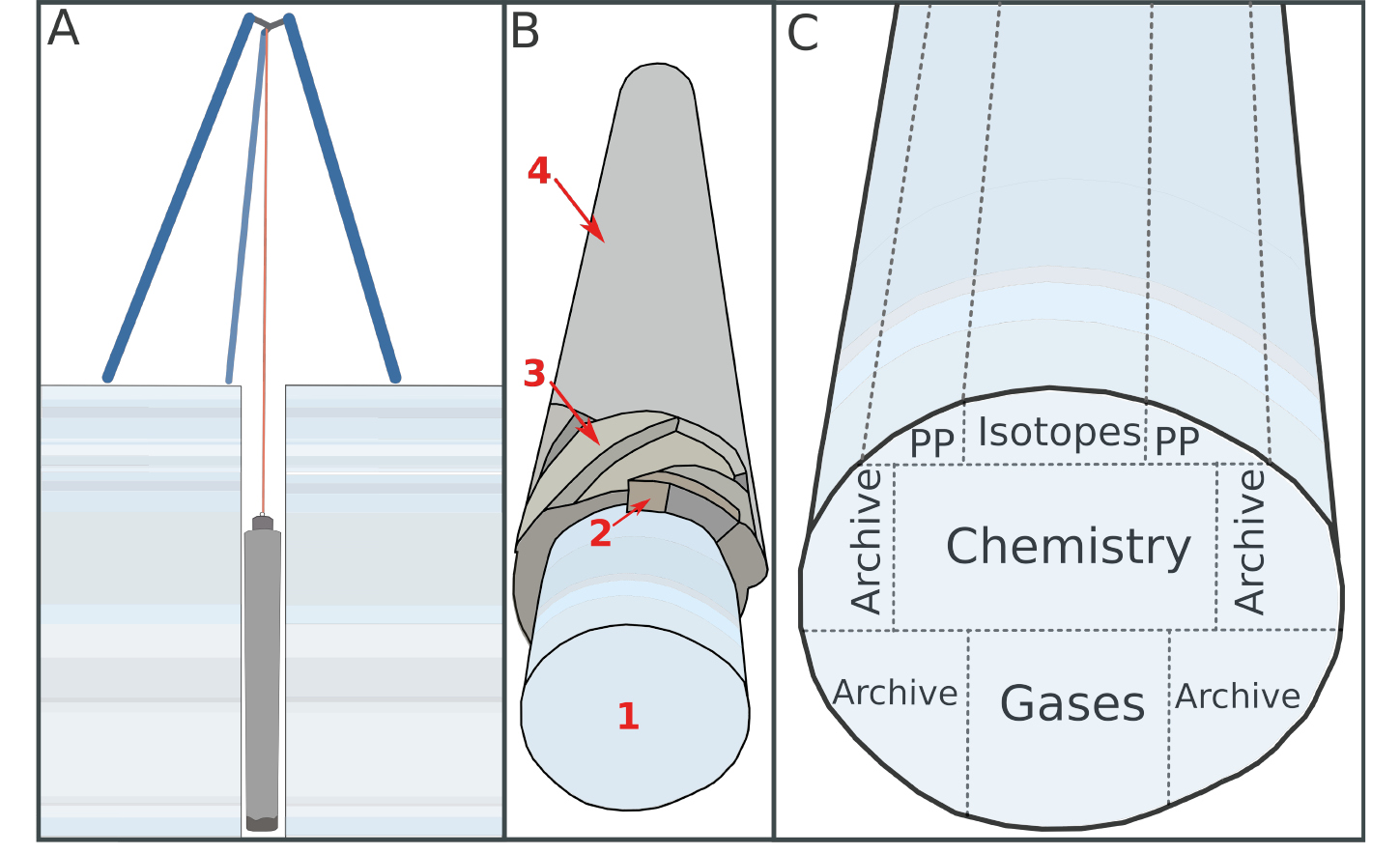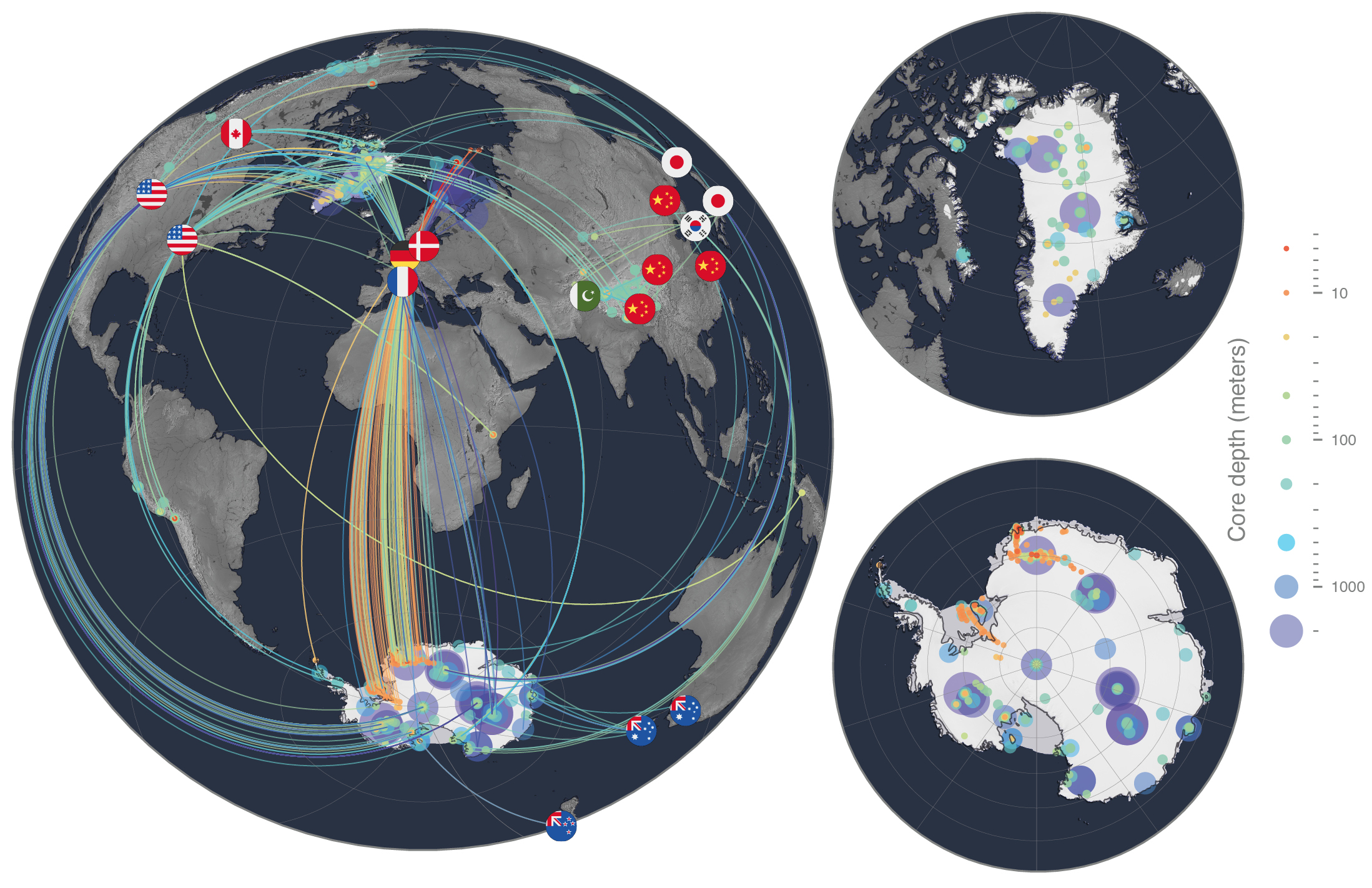- Home
- Publications
- PAGES Magazine
- From Drilling To Data: Retrieval, Transportation, Analysis, and Long-term Storage of Ice-core Samples
From drilling to data: Retrieval, transportation, analysis, and long-term storage of ice-core samples
Davidge L, Brooks HL & Mah ML
Past Global Changes Magazine
30(2)
98-99
2022
Polar and alpine glacial ice is scientifically valuable, but it is logistically challenging to drill, transport, and store. We summarize the process of retrieving and analyzing a new core and identify archived samples that might be available for new research.
Ice cores collected from polar ice sheets and alpine glaciers provide a frozen archive of past atmospheric gases and precipitation that are important to glaciological and climate sciences. Ice-core analyses produce exceptionally well-resolved observations of local, regional, or global changes in the atmosphere over time. This is because as snow falls, a variety of physical processes affect its material properties and composition, and these signals get preserved through time. For example, ice flow direction affects the mineral orientation of frozen water, atmospheric composition determines the particle load and aqueous chemistry of an ice layer, and global and regional temperatures change the isotopic composition of the precipitation falling at an ice-core site; further, atmospheric gases trapped in the pore spaces between ice crystals are preserved and can be measured directly from ice-core samples (Banerjee et al. p. 104). Consequently, there are dozens of analyses that may be desirable to perform on a single ice-core sample. Drilling and preserving ice-core samples is challenging because cores are retrieved from frozen, often remote, and sometimes very deep (i.e. thousands of meters) sites. Despite this, cores are routinely recovered from scientifically advantageous locations, and ice samples are typically archived in storage facilities, where they may be available to support future research.
Drilling an ice core
Though the ice drilling process is similar at most sites, scientific objectives dictate the desired ice volume and depth, and cargo restrictions and site temperature may constrain equipment choices. Most core segments are about 10 cm in diameter and 1 m long, though the exact dimensions are determined by the size of the drill. Most core samples are retrieved by electromechanical drills; these drills contain a hollow cylinder, called the core barrel, that is equipped with rotational cutting teeth at the bottom (see Johnsen et al. 2007). Above the core barrel, an anti-torque device stabilizes the drill within the borehole while the cutters are spinning, and the entire drill assembly is suspended from a tripod or tower by an armored electrical cable (Fig. 1a). The rotating cutters pulverize a ring of ice, leaving a cylindrical pillar intact to enter the core barrel, while the remnant ice chips are removed from the cutting interface by circulating fluid and/or by helical flights (Fig. 1b). Each time the drill has progressed far enough to fill the core barrel, the ice pillar is broken off at its base, and the entire assembly is winched up to the surface. For electromechanical drills, the cutting force is supplied by electric motors, and the rate of penetration can be controlled by changing the weight above the bit. When drilling in ice warmer than -10ºC, mechanical cutters tend to stick, and ice chip transport becomes difficult; at such sites, a ring-shaped heater is typically used to incise the ice instead in a process called thermal drilling (see Zagorodnov and Thompson 2014).
Glaciers and ice sheets are particularly inhospitable drilling environments. At the surface, heavy winds scour and redistribute recent snowfall, often burying scientific equipment or causing large snow drifts. Deeper in the ice sheet, ice flows under its own weight, causing deep boreholes to deform and close over time. Choices about infrastructure and equipment typically balance labor and cargo requirements with drilling efficiency and core quality. For example, drilling within covered trenches is the best way to avoid the impacts of drifting snow and bad weather, but a windscreen or tent might be a preferred alternative at sites where cargo capacity is limited or where the planned drilling season is short. Small drills or hand augers are used in alpine environments, where transporting personnel, equipment, and cores is often done by small aircrafts or even by foot or pack animal (Matoba et al. 2014; Schwikowski et al. 2014). However, deep ice-drilling projects in Greenland and Antarctica—which must penetrate multiple kilometers into the ice sheet—can utilize longer drill barrels, longer and stronger winch cables, and taller towers to minimize the number of trips up the borehole and accelerate the field campaign (Bentley and Koci 2007; Zhang et al. 2014). Boreholes deeper than about 300 m need to be backfilled with drilling fluid to prevent the borehole from collapsing (Talalay et al. 2014), though drilling fluid can also contaminate fractures within the core, which limits possible analyses.
Field storage and transportation
Once at the surface, cores are labeled with orientation and depth information and packaged carefully for transportation. Ice-core samples are susceptible to breakage, alteration, and melt, which means that preserving cores in the field and during transportation requires significant preparation; deep ice cores can be particularly fragile as they are removed from the ice sheet and rapidly decompress at the surface (Neff 2014). To inhibit physical, chemical, and biological alteration, it is desirable to store core samples at temperatures that are comparable to the in-situ temperature of the ice or at a maximum of about -20ºC. Cores are typically placed in insulated shipping boxes for protection during field storage and transportation. At polar drilling sites that remain frozen at the surface year-round, a shallow, covered trench dug into the snow is often enough to insulate the boxed cores for months or years. Storage at alpine glacier sites can be more complicated because these sites tend to be warmer and wetter than polar locations (e.g. Tsushima et al. 2021). Because of this, drilling at alpine sites is often seasonally constrained, and it is important to remove cores from these temperate sites as quickly as possible and place them in freezer storage.
The availability of onsite storage and field access limitations determine the method and frequency of transportation. Because ice cores from many polar sites can be safely stored at the drilling location—and because polar sites are often accessed by fixed-wing aircraft with substantial capacity for cargo—there is typically less urgency around transporting these cores, and their transportation can be scheduled similarly to other field-site cargo (e.g. Slawny et al. 2014). These cores are sometimes moved into temporary freezer storage at permanent research stations before being shipped to their destination country in refrigerated shipping containers aboard cargo ships or in smaller refrigerators aboard large aircrafts. For ground transport, temperature-controlled containers are transported by truck to national archive facilities or university laboratories for analysis.
Distribution and analysis of ice-core samples
Obtaining diverse measurements on an ice core typically requires that core samples be partitioned and distributed to multiple laboratories (Fig. 1c; as in Souney et al. 2014). Core samples are processed in one of two ways: discretely, by cutting the ice into small pieces and measuring the average properties of each subsample; or continuously, by melting one-meter "sticks" of the core from top to bottom and analyzing the resulting melt stream. It is desirable to make continuous measurements from ice-core samples when possible, because this method produces high-resolution timeseries while also minimizing sample handling and the potential for contamination (e.g. Osterberg et al. 2006; Röthlisberger et al. 2000). The volume of ice that is sent to each collaborating laboratory depends on analytical method requirements and project objectives.
Long-term ice-core storage
Notably, a portion of many cores has been archived in long-term storage facilities for use by future investigators. Ice from hundreds of field sites is stored in ice-core repositories within national research centers or universities (Hinkley 2003). Many of these samples are available for future research – and, indeed, many ice-core studies were conceptualized long after the ice core was originally retrieved. We provide a map of selected ice archives in Figure 2. Many core samples can be accessed by contacting the repository and proposing new strategies to leverage existing core samples to answer outstanding research questions.
affiliationS
1Department of Earth and Space Science, University of Washington, Seattle, USA
2School of Earth and Climate Sciences & Climate Change Institute, University of Maine, Orono, USA
3Department of Electrical and Computer Engineering, University of Minnesota, Minneapolis, USA
contact
Lindsey Davidge: ldavidge uw.edu
uw.edu
references
Bentley CR, Koci BR (2007) Ann Glaciol 47: 1-9
Davidge L et al. (2022) Zenodo, doi:10.5281/zenodo.7076469
Johnsen SJ et al. (2007) Ann Glaciol 47: 89-98
Matoba S et al. (2014) Ann Glaciol 55: 83-87
Neff PD (2014) Ann Glaciol 55: 72-82
Osterberg EC et al. (2006) Environ Sci Technol 40: 3355-3361
Röthlisberger R et al. (2000) Environ Sci Technol 34: 338-342
Schwikowski M et al. (2014) Ann Glaciol 55: 131-136
Slawny KR et al. (2014) Ann Glaciol 55: 147-155
Souney JM et al. (2014) Ann Glaciol 55: 15-26
Talalay P et al. (2014) Cold Reg Sci Technol 98: 47-54
Tsushima A et al. (2021) Ann Glaciol 62: 353-359

